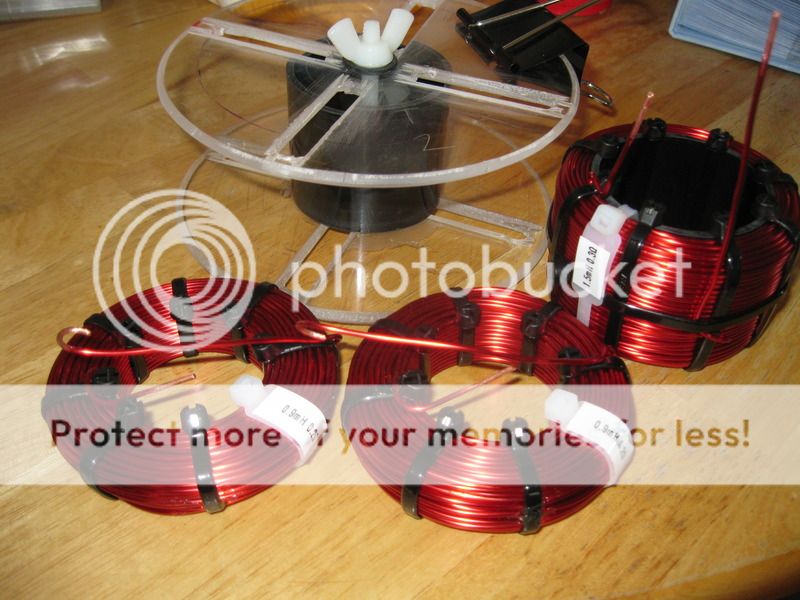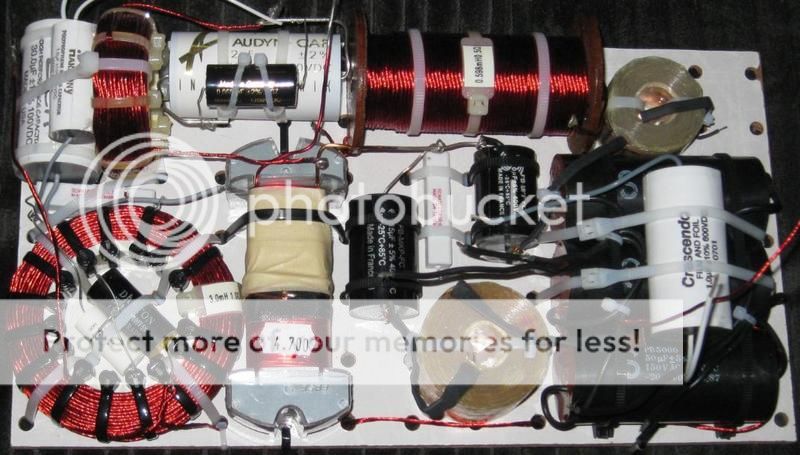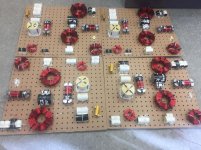One thing to note is that DCR is not necessarily always a bad thing. In certain cases having a few ohms DCR can aid hitting the correct slope in a crossover design, allowing you to use modestly priced air cores.
Yes indeed! I got all sorts of odd flack for saying that earlier.
E
Are you saying you have the same affliction?
my interpretation: You only have enough tie wraps when your crossover can survive being thrown into a wall at 300 MPH.
has anybody done any research on putting small series coils on drivers to filter upper harmonic grit / say 1-4 octaves above the low pass or up on the top above the treble driver. when ising active crossovers i think i am hearing more natural sound yet the attenuation is measuring way down way out there . it would make sense the high pass driver is masking the noise but there is a sense of clean calm sound compared to them not being there. welcome to my hocus pocus lol
has anybody done any research on putting small series coils on drivers to filter upper harmonic grit / say 1-4 octaves above the low pass or up on the top above the treble driver. when ising active crossovers i think i am hearing more natural sound yet the attenuation is measuring way down way out there . it would make sense the high pass driver is masking the noise but there is a sense of clean calm sound compared to them not being there. welcome to my hocus pocus lol
To filter out breakup, resonances, etc of woofers; the best way to do this is a notch of some sort, and not unheard of. Going higher order is not unheard of either.
The rising response of the tweeters or tweeters with resonances or breakup will sometimes be mitigated by a 0.1mh coil in series or a CR in shunt to tilt the response down.
Later,
Wolf
Wolf, were those tests keeping the effective DCR constant when comparing core types? (Like, adding small series resistors to compensate)? Curious whether the effect was core behaviour itself or the difference in the lenght and gauge of wire that is wound on them.
Missed this...
I added resistance in the tweeter shunt to compensate and match. The woofer coils, save for the P-cores, were all really close to start with on purpose. I used 18AWG I-cores to get close DCR for the 14AWG air-cores.
I'm not alone in thinking the P-cores aren't as high power handling as thought. There have been recent testing of a couple builders over on PETT (using an Audio Precision rig) and MAC-DIY that have shown moderate power input to P-cores make them saturate much earlier than presumed by the data sheets. The power handling may be 500W, but that doesn't mean the cores will sound the same at lower and higher power input levels.
At this time, I'm keeping P-cores in the realm of conjugate filters for mids and such. They won't see as much power in that small bandwidth, and the shunting filters will contribute less to the sound being both that and out of driver bandwidth operation.
It really was a surprise about the P-cores' functionality.
Wolf
the truth is that you need to evaluate each component and measure the response.
Each coil has a different DRC and saturation and high frequency problems.
I have nothing against Erse and Jentzen, I use both, but the dayton 4.5mh iron core with 18 gage is not good as in-line.
I tried to build my own coils, but it is time consuming and not perfect at all.
The big problem when building diy speakers is that you purchase some coils + adjustment coils like 0.05mh and 0.1mh and place them in series, BUT it never works as predicted. IMO you need hundreds of coils to make a good speaker, otherwise you make compromise.
Each coil has a different DRC and saturation and high frequency problems.
I have nothing against Erse and Jentzen, I use both, but the dayton 4.5mh iron core with 18 gage is not good as in-line.
I tried to build my own coils, but it is time consuming and not perfect at all.
The big problem when building diy speakers is that you purchase some coils + adjustment coils like 0.05mh and 0.1mh and place them in series, BUT it never works as predicted. IMO you need hundreds of coils to make a good speaker, otherwise you make compromise.
You need to spread the crossovers out to avoid inductor interaction
These 4 crossover boards are 24 x 24 inches each and theres 4 of them for clones of JBL 4350 monitors
All low frequency coils are 12 awg iron and caps are bypasssed metalized polypropylene film
The mid horn circuits are air core coils and MIT film and foil Polypropylene and tweeters are 18/octave film and foil MIT Polystyrene
These 4 crossover boards are 24 x 24 inches each and theres 4 of them for clones of JBL 4350 monitors
All low frequency coils are 12 awg iron and caps are bypasssed metalized polypropylene film
The mid horn circuits are air core coils and MIT film and foil Polypropylene and tweeters are 18/octave film and foil MIT Polystyrene
Attachments
Last edited:
Wow, those crossovers look like there’s a lot going on there, much better parts than what they would have had originally I’m sure.
The 4406 crossovers that I cloned for the car are much more simple, made my own coils for those.
After some reading, I found there are some trade offs based on which proportions one chooses when making coils.
The 4406 crossovers that I cloned for the car are much more simple, made my own coils for those.
After some reading, I found there are some trade offs based on which proportions one chooses when making coils.
You need to spread the crossovers out to avoid inductor interaction
These 4 crossover boards are 24 x 24 inches each and theres 4 of them for clones of JBL 4350 monitors
All low frequency coils are 12 awg iron and caps are bypasssed metalized polypropylene film
The mid horn circuits are air core coils and MIT film and foil Polypropylene and tweeters are 18/octave film and foil MIT Polystyrene
I recognize ERSE parts, very good. There are no rules for inductors to use. Use what gives you the best results. Sometimes imperfect inductors is ok, sometimes low DRC is good, sometimes not.
I would like to add that for generic use to design XO I don't like wire gage bellow 16, 18 has a different sound which is not as good, 20 gage is not fun to use. I find that 14 gage too has not a very good advantage over 16.
I have some foils but I like the 16 gage the same.
foils are more damped to reduce vibration, supposedly the inter-windings capacitance is reduced, so less microphonics.
Is this possible to hear is another question, however it could help reduce interaction between multiple coils resonances, lower thd, help with back emf, this is just suppositions.
A slight variation of R or I or C in a coil makes it impossible to truly compare with another. I think we will never be able to AB test any coils.
Is this possible to hear is another question, however it could help reduce interaction between multiple coils resonances, lower thd, help with back emf, this is just suppositions.
A slight variation of R or I or C in a coil makes it impossible to truly compare with another. I think we will never be able to AB test any coils.
I plan on replacing my JBL LF core from
to

Mundorf MCoil N300-2,2mH :: N300 :: MCoil Zero Ohm :: Mundorf MCoil :: Inductors :: Passive Components :: Electronic Parts :: Banzai Music GmbH
An externally hosted image should be here but it was not working when we last tested it.
An externally hosted image should be here but it was not working when we last tested it.
to
Mundorf MCoil N300-2,2mH :: N300 :: MCoil Zero Ohm :: Mundorf MCoil :: Inductors :: Passive Components :: Electronic Parts :: Banzai Music GmbH
- Status
- This old topic is closed. If you want to reopen this topic, contact a moderator using the "Report Post" button.
- Home
- Design & Build
- Parts
- The best inductors?


